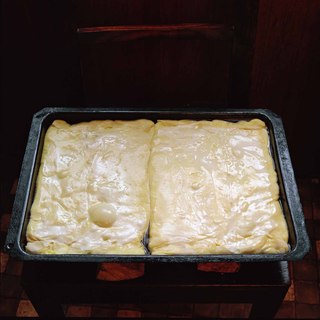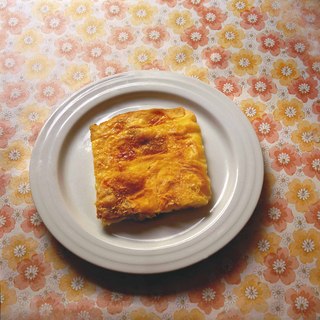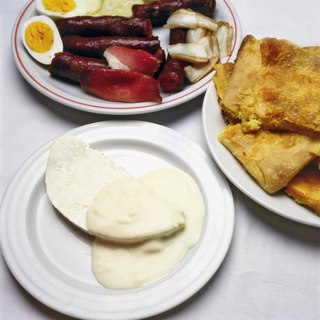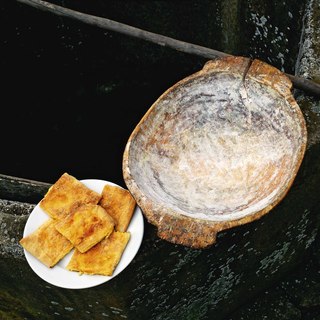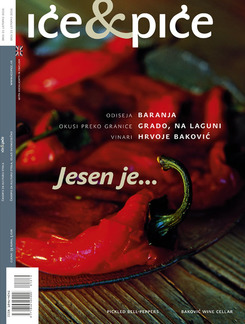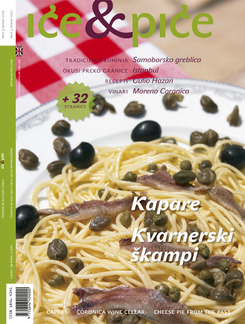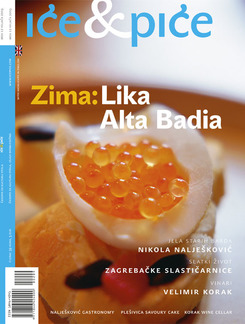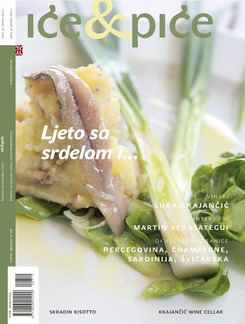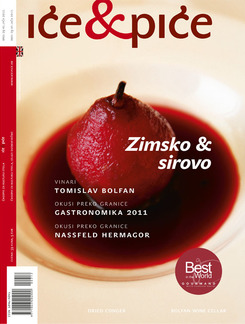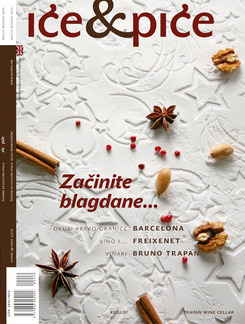The invention of traditional cuisine
Dietary habits are never a complete and finished system, rather an eternally dynamic process of adoption and adjustment. Today many curse the globalised world in which food is becoming disturbingly plastic, and it’s necessary to think up a traditional national cooking style once again. Laments for the demise of good old dishes are matched with the publication of old cookery books, searching through the flimsy and stained pages of great-grandma’s kitchen notebooks, writing out nostalgic gastronomic literature and the organisation of event after event lumped together under the name what our old folks ate. But luckily the fashion for dietary neo-traditionalism hasn’t been overtaken by purism, for if we really wanted to bring everyday old vernacular menus back to life we would be hungry and the gastronomic events would have to be entitled, as Branimir Donat wittily concluded, what our old folks starved on.
Strukli are certainly one of the general favourites of the vernacular cooking style; now they have been elevated to the level of national dish, a part of the intangible cultural heritage. In fact, this is a simple peasant dish. It’s filling and it uses the ingredients that the rural household produced. The cow gave full-fat milk, the hens laid yellow-yolked eggs, and there always had to be flour at home anyway. The housewife would pull out the dough and spread over it cheese, apples, pumpkin, depending on the season of course and what happened to be in the larder. The advantage of filling it with fresh cheese would be that this kind of strudel was capable of being either savoury for a main course or a sweet ending to a rich meal. From one strudel you could get a boiled dish and a dessert. Still today a frequent and quick lunch is some hearty soup like chicken with vegetables, cauliflower or mushroom cream, and cheese strudel. On the tables of the poorer poor, boiled or baked strukli were a more festive and abundant dish that had to stand out from the monotony of the vegetable stews and the boiled grains that on the whole served to staunch hunger. Because of its origin, and there is no attempt to present it as anything refined, the dish of strukli has been falsely called a primitive food, Miljenko Jergović thus exciting a heated discussion in the media about the origin and importance of strukli. Everyone combined to attack the lament of the hero of the novel Freelander about strukli, feeling the need to close ranks against this assault on the much-loved domestic gastronomic icon. The Jergović gastronomic betrayal at last clearly showed that strukli had escaped from its regional origin and become an acknowledged national dish, although it is very obvious that it is not traditional in the Mediterranean part of Croatia. The polemics showed that identity can be discussed at table, and the aroused public decided resolutely to defend their plates from criticisms that they were not indigenous, entirely confusing the conceptions of authentic and traditional.
Filo rolls – strudels, strukli, burek and pie
Dishes of filo pastry with various fillings are shared with the whole of the neighboured, and we munch strudels together with the whole of central Europe. Pies and bureks too belong to the same family of dishes with thin filo pastry. It’s almost impossible to define precisely where this pastry was thought up or where cinnamon-fragrant apple strudel was first baked. But it’s not needed either, as long as we keep a place on our tables for these filo rolls. Recipes pay scant respect to national boundaries, and similar recipes for strudels can be found in the cook-books of Austria, Bohemia, Croatia and Slovenia. In the fight to find one’s own gastronomic identity, with our mouths full of strudel, we keep quiet about sharing our fondness for it with the Slovenes and Austrians. For they really were created somewhere on the hearths of Austro-Hungary, where the most diverse strudels were rolled up, savoury and sweet.
The availability of natural resources is crucial for the shaping of a cuisine, and local natural generosity or parsimony dictated what simmered in the pots and pans of central European kitchens. The poor thought up how to fill their eternally empty stomachs, while those that were satiated created a table culture, always open to ingredients coming from afar. The advantage and cause of the diffusion of many variations of strudels is their ability to be transformed, the same virtue that made pizza a dish that in countless versions has been adapted to all tastes. Filo pastry rolled out thin and greased can be filled with everything that happens to be around in or around the house at the time. Strudel is great with cherries and apples, or cheese, pumpkin or spinach. Filling it with mushrooms, vegetables, minced meat or fruit, we bring to life the innumerable inventions with which adroit kitchen hands have tried to abolish dietary monotony, and, wrapping common ingredients in a flaky crust, have thought up new recipes.
Domesticating strudel
The first known recipe for a dish entitled strukli is found in the oldest Slovene cookbook called Kuharske bukve, printed in 1799 by the Slovene Revival figure Valentin Vodnik (the people of Zagreb repaid him calling a street in the centre of town after him). But strukli was (the word is plural, but it’s better in English to think of it as a dish) eaten outside the borders of Slovenia, and were a common vernacular treat on the tables of NW Croatia. But since Croatian cooking terms are still a lexical nightmare, it’s hard to follow the turns in the various forms of strudel, coming from the German and domesticated into several Croatian forms, and then there are the forms gibanica and guzvara. The first Croatian language cookbook, Nova-z-kup szlosena szkochka knjiga by Ivan Birling, printed in 1813, uses the name strukli for a dish that we would call strudel today, and in the part of the book dedicated to strukli we can also find the name gibanica, which is in fact a kind of sweet pie filled with alternate layers of grated cheese, raisins and cheese all reinforced with an egg or six. At a time when most of the people were bilingual, handling German and Croatia not only in the kitchen, writing a cookbook in Croatian was a serious matter. This was diagnosed some fifty years after Birling by Gjuro Deželić in his New Croatian Cookbook of 1868, deciding that there as a confusion in the main Croatian-German dictionary to do with the word povitica. He proposed that the confusion about strudel be settled, as he himself said, with the common name of savijača – roll – but still left the terms povitica and savitnjaci, suggesting wrapping and rolling retrospectively. He realised that he had to add a glossary of less well known terms, and he added to Croatian words the corresponding German phrase, asking cooks and young people to note down the names of cakes they came across and then report them to him or the lexicographers to the great profit of literature. The Zagreb Cook Book of Marija Kumičić, assumed to have been published at the end of the 19th century, settled this language problem with the word gibanica and yet added – so that it would be understood – strudel. The tangles of language have not yet been properly straightened out, and there are many other words, while the differences between the food is not always to explain. Not even today does the word strukli mean always the same thing, and it is not the only word used to designate a sweet or savoury dish of filo pastry. In part of Istria, for example, strukli is used to refer to gnocchi. When we have unriddled the old recipes, we see that today’s strukli that come to the table with a tasty crust of baked (sour) cream is just one of the many kinds that steamed on the tables of bourgeoisie and folk in the 19th and the early 20th century, rejoicing the palate in so many Lenten days. Birling’s cookery book mentions nine kinds of, mainly sweet, strudel. Among the fillings of semolina, cheese, cream and grated bread rolls, strukli of almonds and spinach stand out, which in their cooked or baked versions are certainly deserving of a new interpretation.
Today’s Zagorje or Croatian strukli are not picked out by their ingredients, rather the technique. You have to pull out the pastry very fine on a tablecloth; every experienced cook I have ever spoken too says it’s a very simple matter, but the exploit of stretching pastry out over a whole table is one of the kitchen activities that can bring even an above averagely adept cook to tears. Good cooks can be recognised in simple foods, but these dishes have to be prepared a hundred times. You have to have at your finger tips the amount of water, the firmness of the dough, the patience and the tenderness to keep the sheet of pastry in one piece. This last is almost impossibly difficult to achieve and one of the reasons why I would advise any novice in pastry-stretching, among whom I include myself, to buy the filo pastry readymade and avoid that incapacity you feel in the face of tearing pastry. When the pastry has given in and decided to stay in a single piece, then you coat it with a mixture of fresh cheese (i.e. cottage cheese) and egg. Then you role it up in the tablecloth and cut the thick edge with a saucer. This cutting stops the filling escaping, and it is this trick that’s a special feature of strukli that, unlike strudel, is first cooked, and can then be baked, covered in cream, fresh or sour, to taste.
New old strukli
The dissemination of the strukli as a national dish in Croatia has been helped by the appearance of ready cooked products for sale. The first frozen strukli came from the famed Esplanade kitchen, which brought strukli into pot and oven much further to the south than hitherto, while they were later produced by the Ledo factory. Availability lets some dish escape from the regional framework in which it has been traditionally prepared. It’s hard to imagine any pure-blooded Dalmatian woman deciding to make a Zagorje dish from scratch, but this is a dish that is offered as assistance in busy daily schedules that leave too little time for cooking meals. And while other prepared foods are still looked at with distrust, strukli, by some miracle, will pass as a suitable replacement for a cooked lunch. Frozen food is still perceived as a result of insufficient attention, of the kind that always knew that the way to the heart is through the stomach. Strukli are perhaps acceptable, for it’s relatively difficult to make them from scratch, unlike risotto or breaded cutlets. The supply of traditional prepared frozen foods is neither rich nor appetising, but strukli and knedels have won their places on menus throughout the country. Now the roseate strukli are prepared in areas that through history paid much more attention to cheese production. For it should be clear that the fancy invested into dishes with fresh cheese and cream of the Croatian north comes out of the poverty of the supply of hard and more characterful cheeses. So strukli is typical of the region in which fresh cottage cheese prevails, endlessly attractive with cream, corn bread, spring onion and radishes, but in all honesty, its unquestioned rule also reveals a large amount of impatience to do with cheese making – this aspiration for milk to achieve immortality.
Many kinds of strukli have been forgotten, driven out by those with cheese, but they have developed into all-round bites that are offered guests with pride, showing that in the inland part of Croatia independent dishes can be found that are capable of meeting the needs of carnivores and herbivores. You just have to flick through the old cookbooks and let your fancy run wild, and once again the tables will feature strukli with buckwheat, spinach, almonds, fruits of the forest or cream. But while we are awaiting the return of the old and the arrival of new kinds, those fat little cushions called vanjkušek [like ravioli], will commonly be eaten boiled and scattered with fried breadcrumbs, arranged in soup, when the pastry melts and the bit of escaping filling gives flavour to the soup that some season with cream and parsley, others with roux and paprika. But they are most common in their first boiled and then baked version, which does away with the crunch of the strudel, but does achieved a delicious creamy merging of filling and wrapping. The strukli we eat today comes out of the oven pursy and irresistible, fragrant and always too hot, and while they are calmly cooling in front of impatient forks and spoons, it’s no longer important if they are from Croatia or Zagorje, original or traditional, only that they should get cold enough now.
